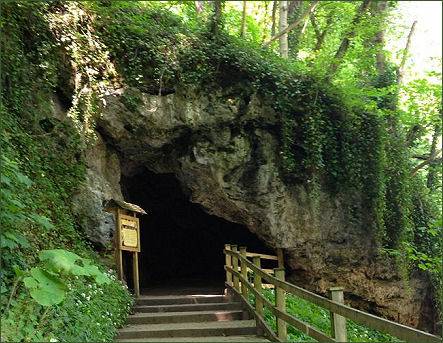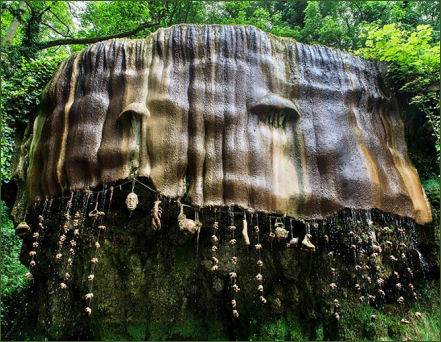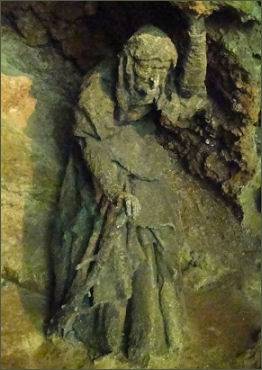Mother Shipton's Cave
OS grid reference:- SE 347 569
Mother Shipton's Cave is situated at Knaresborough, near to the River Nidd. Nearby is a petrifying well which is the oldest charging tourist attraction in England, having been open since 1630.


The cave is associated with the legendary soothsayer and prophetess Mother Shipton (circa 1488 - 1561), born Ursula Southeil, wife of Toby Shipton. According to legend she was born in the cave. Over the years, millions of people have come to see for themselves the amazing powers of the Petrifying Well. This ancient well, formerly known as the Dropping Well, is believed to be the only one of its kind in England. It is only in the last 150 years that scientific analysis has revealed exactly what lies behind the magical petrification process. It is a natural phenomenon due to the high mineral content of the water. Compared to a stalactite or stalagmite, the items petrify very quickly. Today's visitor to the Petrifying Well can see a whole host of everyday objects slowly being petrified in the cascading waters. The most popular item is a teddy bear or soft toy which usually takes between three and five months to turn to stone.
The Cave and Well lie at the heart of the Mother Shipton Estate, a mile long remnant of the Ancient Forest of Knaresborough. There are riverside walks withviews of old Knaresborough. The cave and dropping well, together with other attractions are open to visitors and are run by Mother Shipton's Cave Ltd.
Directions
Mother Shipton's Cave is situated just off the Harrogate road (A59) and on Long Walk, which runs alongside the gorge of the river Nidd, just half a mile south of Harrogate town centre.
Ursula Shipton
 Mother Shipton was born as Ursula Sontheil in 1488, during the reign of Henry VII, the first Tudor king. Little is known about her parents, but legend relates that she was born during a violent thunderstorm in a cave on the banks of the River Nidd in Knaresborough. The woman who had acted as midwife is said to have reported a great crack of thunder and a pungent smell of brimstone at the moment Ursula appeared into the world.
Mother Shipton was born as Ursula Sontheil in 1488, during the reign of Henry VII, the first Tudor king. Little is known about her parents, but legend relates that she was born during a violent thunderstorm in a cave on the banks of the River Nidd in Knaresborough. The woman who had acted as midwife is said to have reported a great crack of thunder and a pungent smell of brimstone at the moment Ursula appeared into the world.
Ursula's mother, Agatha, was just fifteen years old when she gave birth, and despite being taken before the local magistrate, she would not be prevailed upon to reveal the identity of the father. With no family to support her, Agatha and Ursula lived in the cave for two years before the Abbott of Beverley took pity on them and a local family took Ursula in. Agatha was taken to a nunnery far away, where she died some years later. She never saw her daughter again.
At the age of 24 Ursula married Tobias Shipton, a carpenter from York but he died a few years after the marriage. As well as making traditional remedies, Mother Shipton claimed she could predict the future.
Many local people, including the nobility and an abbot, came to seek her advice on medical problems. Mother Shipton became famous for her prophecies with regard to many future events including the plague, the civil war and the Great Fire of London, the coming of cars, trains, iron ships and submarines. She became known known as Knaresborough's Prophetess, was regarded as a witch and made a living telling the future.
Mother Shipton died in 1561, at the age of 73, she was reported to have been buried in unconsecrated ground on the outskirts of York, possibly between the villages of Clifton and Shipton. A stone monument was said to have been erected on the site, bearing the inscription "Here ly's she who never ly'd, Whose skill often has been try'd.
Her prophecies were first published in a pamphlet in 1641 and reprinted in 1645 by William Lilly the prominent astrologist, the diarist Samuel Pepys mentions her in his diary wrote during the Great Fire of London in 1666.
